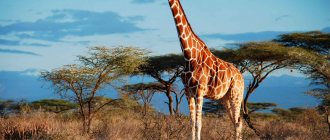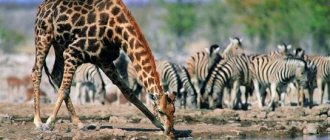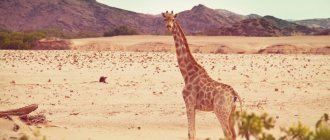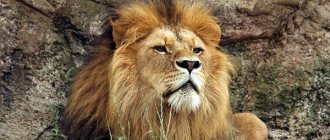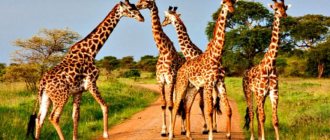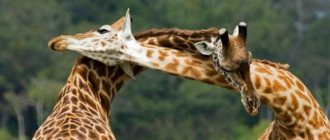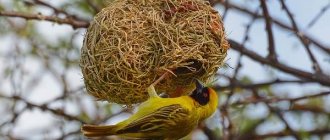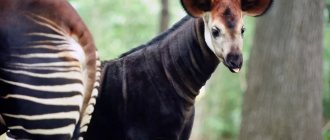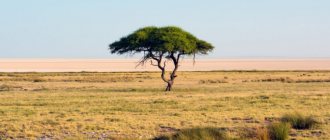- Reports
- Animals
- Giraffe
Giraffes are mammals that belong to the artiodactyl group. The height of these artiodactyls reaches 6 meters, so they are considered the tallest land animals on our entire planet.
The weight of this animal is usually about 1 ton. A characteristic feature of giraffes is their neck, which makes up a third of the entire length of this animal. Such enormous height and long neck allow giraffes to obtain food from trees at very high altitudes with their muscular and very long tongue. The tongue of these mammals can protrude almost half a meter from the mouth, so they can even clean their ears with their tongue if necessary.
The color of giraffes is very unique and beautiful. Their skin has a pattern of dark spots on a light yellow background. Each individual has its own individual skin pattern, like human fingerprints. Giraffes have two small horns on their heads, which are covered with skin. Giraffes have large eyes and long eyelashes.
The legs of these animals are relatively thin, but giraffes run very fast. These animals can reach an average car speed of 60 km/h. Also, these artiodactyls jump relatively well; the jump height of giraffes reaches 1.5 m.
Giraffes are ruminant artiodactyls, so they feed on vegetation. The main plants that these animals eat are: acacia, mimosa, and apricot shoots. Giraffes can go without water for a very long time if they eat succulent leaves of plants. If a giraffe comes to water bodies to drink, then at one time it can drink 38 liters at once.
These animals live only in Africa, mainly in the south and southeast of the Sahara Desert.
Giraffes settle next to zebras and antelopes, living either alone or in small herds.
There are 6 species of these animals, but today only one species exists, the rest are considered extinct. The existing giraffe species is divided into 9 subspecies: Nubian, Angolan, reticulated, Masai, Kordofan, Ugandan, South African, West African, Thornycrofta.
The enemies of giraffes are lions, hyenas, and leopards, who love to hunt the cubs of these artiodactyls. As a rule, they do not touch adult giraffes.
Despite the fact that people hunt these animals, and their population is small today, giraffes are not considered endangered animals on our planet. They breed very well in captivity and are kept in many zoos around the world.
Appearance
This species of mammal is the tallest living on the globe. Like many other representatives of artiodactyls, the male is larger than the female.
Its height ranges from 5-5 to 6-2 meters, and females from 4-6 to 5-8, respectively. You also need to pay attention to the fact that his height is greatly increased by his neck, which is 1.3 times the length of the giraffe’s entire body. Its weight ranges from 925-1250 kg.
A few more words about the neck of our giant; in practice, we have always observed seven cervical vertebrae in most individuals of this species. It would seem like nothing special, if not for one thing, but! The giraffe also has seven of them, but given the length of its neck, it makes you wonder how this is possible.
We have one explanation; nature foresaw everything in advance. Plus, the giraffe's body at one time suffered strong genetic changes. There is an opinion among scientists that it stretched out due to the fact that the animals fought with their necks against each other.
Why does a giraffe need horns on its head?
The growths on the head of giraffes are called ossicones. Animals of both sexes have horns; their length in adults reaches 20-25 cm. Newly born giraffes also have ossicones, but they are not attached to the skull and can bend in different directions.
Most likely, the outgrowths are rudiments that giraffes have left from their distant relatives - deer. They are covered with skin and hair, and unlike deer antlers, they consist of ossified cartilaginous tissue. Adult males use horns during fights with competitors. This is the only purpose of the outgrowths, as they are too small to protect against enemy attacks.
ZEBU
Circulatory system and its features
The size of the animal causes a lot of trouble for the mammal’s circulatory system and its heart. The whole point is to supply the brain with oxygen, you need to overcome a significant distance of the blood substance through the vessels.
Personally, we were surprised when we learned that in one minute the heart of an African giraffe pumps more than 60 liters of blood. To put it mildly, not a very modest volume, especially if you imagine that these are 6 buckets of liquid, which are filled to capacity.
His heart is strong and weighs more than 11 kilograms; it is capable of creating pressure several times greater than that of a person.
However, even such powerful characteristics of the heart would not cope with the load if the animal sharply lowered and raised its head. Therefore, nature also provided this, so that it does not die from a cerebral hemorrhage; the giraffe’s blood has the thickest form with a significant number of blood cells in it.
And that’s not all, in case the giant has valves in the large cervical artery that can lock and block the sharp pressure of blood rushing to the brain.
This is interesting
The size of a giraffe's tongue can surprise any person; it is more than 46 cm long, which it can release outwards. Its color is black, has a muscular structure and can easily break acacia branches.
The upper part of the body is covered with patterns in the form of reddish spots, which for each representative have an individual location and shape, similar to human fingerprints.
The lower part is unspotted and slightly lighter. At the very top of the head are two horns with blunt ends, and on the forehead there is a bony convex plate that may also resemble a third horn. The eyes are black, fringed with long and thick eyelashes, and the auditory conchas are short.
Photo of a giraffe in good resolution
It should be noted that our hero has excellent vision, smell and hearing. A potential threat to his life and health can be detected 1 kilometer away and have time to leave the dangerous place.
Animals of Africa The giraffe can reach speeds for short distances of up to 57 km/h, thereby gradually moving into a gallop. This means he is capable of outpacing a professional racing horse competing in international racing. Animals, due to their thin legs and heavy weight, are not able to walk through swampy places, and rivers are not at all surmountable obstacles for them.
An interesting note is the fact that, with such body weight and height, he can jump over obstacles of more than 1 meter and 90 centimeters in height.
general description
A giraffe, 6 meters tall, weighs up to 2 tons. The largest animals on the planet are the elephant, rhinoceros and hippopotamus. The giraffe has a long neck - as much as 1.5 meters! Like other mammals, it has 7 vertebrae, only they are very elongated.
Most giraffes are two-horned, but sometimes there are animals with 4 or even 5 horns on their heads. Its yellowish-red skin is decorated with dark brown round spots. No two giraffes are alike in Africa. Each skin is colored differently and is individual, like a person’s fingerprints.
These African animals have very expressive eyes with thick black eyelashes.
Habitat
Today, giraffes are widespread in the southern and eastern-southern parts of the Sahara Desert. These places are considered to be:
- East Africa;
- South Africa;
In the northern part of the desert, the population was completely exterminated by humanity in ancient times. During ancient Egypt, they were common in the delta along the Nile River and on the Mediterranean coast. In the twentieth century, their range declined again. The most populated places where you can meet the spotted giant are nature reserves and reserves.
Nutrition
Animals prefer only plant foods; he especially loves to eat acacia leaves. The giraffe is the tallest animal and thanks to its height, it deftly releases its long tongue, covers the branch and throws its head back, thereby emptying the branch of leaves. He can eat up to 30 kilograms of vegetation per day.
It receives water from plants and can go without water for several weeks. If he still wants to drink enough, he is forced to spread his legs wide so that his head can touch the base of the reservoir. In one sitting he is able to drink up to 40 liters of water. But the animal is very vulnerable at this time and he engages in this procedure when he is convinced that he is not in danger.
Lifestyle
African giants can lead a solitary, gregarious lifestyle that does not bind them to each other. They can travel up to one hundred kilometers in search of food. Females prefer to live from 4 to 35 individuals in a herd. They have no leaders, there are only elders who have some weight among the younger generation.
You can also see a young giraffe wandering with the herd:
- Antelope;
- Zebra;
This makes him feel safe. Because when two tall males meet, it almost always leads to a fight. If a fight cannot be avoided, then two opponents stand against each other and try to headbutt the opponent’s neck.
It is noteworthy but true that after a defeat, the opponent does not drive the loser out of the herd, as other types of social mammals do.
He sleeps from ten minutes to 2 hours a day. They can sleep standing and lying down. It’s interesting, but no one has yet been able to fix a natural posture during sleep.
Report on the giraffe - a brief description and interesting facts for children
We have prepared for you several reports about giraffes, their habitats and interesting features of these animals. Use our material to prepare your essay for school (grades 3-7)
Report No. 1
One of the most interesting inhabitants of the African savannah is the giraffe. This is the tallest animal on the planet. His height reaches 6 meters, that is, he is taller than a two-story house. Giraffes live only in Africa. The report will tell you more about them.
general description
A giraffe, 6 meters tall, weighs up to 2 tons. The largest animals on the planet are the elephant, rhinoceros and hippopotamus. The giraffe has a long neck - as much as 1.5 meters! Like other mammals, it has 7 vertebrae, only they are very elongated.
Most giraffes are two-horned, but sometimes there are animals with 4 or even 5 horns on their heads. Its yellowish-red skin is decorated with dark brown round spots. No two giraffes are alike in Africa. Each skin is colored differently and is individual, like a person’s fingerprints.
These African animals have very expressive eyes with thick black eyelashes.
Lifestyle
Giraffes are not very attached to each other. They graze alone or in small groups of 4-10 animals. Sometimes there are herds of 20-30 individuals. Their main food is tree leaves; they especially love thorny acacia. It is difficult for giraffes to bend their necks, so they only nibble grass in times of hunger. The tallest mammal on Earth spends 20 hours a day eating! He eats 30-40 kg of greens per day. He sleeps only 1-2 hours lying on the ground.
A giraffe can live without water even longer than a camel. But he drinks 40 liters at a time.
This is a very peaceful animal; fights between them are extremely rare.
Giraffes can walk only on a solid plain and only in two ways: at a gallop, throwing forward first 2 front legs, then 2 hind legs, or at an amble, moving 2 left legs in turn, then 2 right ones.
Such a large animal has few enemies: lion, leopard, tiger. The giraffe escapes by running, reaching speeds of up to 60 km/h, but it can also enter into battle with the predator. A giraffe can break a lion's skull with a powerful blow from its hoof.
In the wild, these artiodactyls live 30 years, in captivity they live up to 40 years.
Reproduction
The female can become a mother from the age of 4. The mating season of animals occurs during the rainy season. Pregnancy lasts 1.5 years. Only one baby is always born, weighing 50-70 kg and 2 meters tall! Within an hour he stands on his thin legs, and after two he runs briskly.
The female feeds the baby giraffe with milk. At the age of 2-3 weeks, the baby already knows how to get food for itself, but suckles from its mother for 1.5 years.
This is interesting
• The giraffe literally has the biggest heart on Earth. It weighs 10-12 kg and passes 60 liters of blood through itself at a time. • The animal's tongue is completely black and is half a meter long. Giraffes lick themselves with their tongues, like domestic cats. • They are able to jump over obstacles 2 meters high. • The female gives birth while standing, and the newborn giraffe falls to the ground from a height of 2 meters. • Giraffe grows up to 6 years. • When an animal gallops, its long neck swings from side to side in a figure eight. It looks like it might get tied in a knot. • Scientists used to think that giraffes were voiceless. Only recently it became clear that they “talk” to each other, but inaudibly to the human ear.
Report No. 2
The giraffe (Giraffa camelopardalis) is a rather colorful and unusual in appearance animal, belonging to the class mammals, order ruminant artiodactyls, family giraffidae, genus giraffes.
The giraffe is the tallest animal in the world. The height (height) of the giraffe reaches 5.5 - 6.1 meters, a third of which falls on its famous neck. The weight of a male giraffe can range from 500 kg to 1900 kg, and the heart weighs as much as 12 kg: about 60 liters of blood passes through its valves per minute, and the pressure inside the vessels exceeds the standard pressure of an average person by 3 times. Due to the high density of blood, even a sharp change in the position of the giraffe’s head does not lead to a deterioration in the animal’s condition. Despite its impressive length, the giraffe’s neck fully meets the standard characteristics of a mammal - the giraffe has 7 cervical vertebrae, each of which reaches a length of 25 cm. The main jugular vein has in its design special locking valves that are responsible for a uniform supply of blood with the same pressure.
Giraffe tongue
The giraffe has a rather interesting tongue: it is dark, almost brown, long and very muscular, it allows the animal to grab tree branches at a great height, protruding 40-45 cm. With such a long tongue, giraffes can even clean their own ears.
Giraffe color
The color of the giraffe is also worthy of attention: the pattern of spots on the skin is absolutely unique and individual, like a person’s fingerprints, and is never repeated in two individuals. The head of both the male and female giraffe is decorated with a pair of horns covered with fur, large eyes bordered by long eyelashes and small ears crown the elongated head of the giraffe.
Giraffe legs
Despite their thin legs in relation to their overall size, these mammals run well (the giraffe's speed is 60 km/h) and jump well, overcoming barriers more than 1.5 meters high. True, the tallest animal in the world can only actively move on a hard surface - the giraffe avoids swampy soil and rivers.
How do giraffes sleep?
The giraffe bends its long legs under itself, moving one of them to the side, and then, bending into a ball, puts its head on its croup. Giraffes can also sleep standing up.
Sleep does not last long: during the night the giraffe gets up every now and then to drink or eat something. The mammal does not require many hours of sleep - a giraffe only needs from 10 minutes to 2 hours of sleep per day.
Types of giraffes
In the giraffe family, only 1 species of giraffe is distinguished; the remaining 5 species are considered extinct. Giraffes are classified mainly depending on where the animal lives and its color pattern. Experts count 9 subspecies (varieties) of giraffes: Nubian, Ugandan, reticulated, Angolan, South African.
Where does the giraffe live?
The giraffe lives in the savannas of sunny Africa; the giraffe does not live on other continents. Over the past 50 years, herds of giraffes can often be found in the southern and south-eastern regions of the Sahara, as well as drier areas of uninhabited land. Due to its elongated body structure and low water consumption, this animal can live in the open forests of Africa.
What does a giraffe eat?
This type of mammal has a four-chamber stomach, completely adapted to plant food. Ruminant jaws help grind coarse tree leaves and branches of young bushes; for repeated chewing, giraffes can regurgitate food from the first chamber of the stomach. The main dish for the giraffe remains juicy acacia; less often, giraffes eat mimosa and sweetish shoots of wild apricot. Every day he consumes about 30 kg of food and spends 16-20 hours a day eating. Feeding on succulent leaves, the giraffe can go without water for a long time. When a giraffe drinks, it spreads its front legs wide to lower its head toward the water. A giraffe can drink up to 38 liters of water at one time.
Giraffe breeding
Giraffes usually live alone or in small herds, often settling near antelopes or zebras for greater safety. Polygamy is a distinctive feature of giraffes: adult males scrupulously protect their spotted harem from outside attacks, but in turn happily mate with many females. The prime breeding season is considered to be the rainy season in Africa, from July to September. The female's pregnancy lasts 14-15 months. A timely conceived giraffe calf is born in dry, stable weather, which allows it to calmly get to its feet. Birth occurs while standing, so the little giraffe falls from a height of two meters.
Reproduction
During the mating season, a wild giraffe behaves extremely aggressively towards other males. As a result, a conflict of a physical nature occurs, in which a weak opponent may receive injuries incompatible with life.
The most dangerous blows that can cause injury are a downward strike with both legs. This can be compared to chopping wood, when an ax in a person’s hands flies onto a stump. There are several animals that will lure using similar tactics:
- Moose;
- Roe deer;
- Deer;
- Okapi animal;
Many people naively believe that the giraffe does not have a voice, but they are forced to disappoint such people. Animals can talk to each other by making sounds at a certain frequency from 20 Hz.
Animals mate from July to September. The female carries the fetus for 13 to 15 months. There are 1 rarely 2 cubs in a litter. The most severe test for a fetus is flying from a height of 2 meters after birth.
Its height is up to 2 meters in height, and its weight does not exceed 55 kg. A little time will pass, about three hours, and he will stand firmly on his legs. Then he begins to frolic, and after three weeks he joins the herd. She will stay with her mother until she is one and a half years old.
Natural enemies of the giraffe in nature
Adult animals are rarely the target of attack. Giraffes, of impressive size, fight off enemies with powerful front hooves that can cause fatal injuries even to large predators.
Most often, cubs and young, insufficiently strong individuals become victims of lions, leopards and hyenas. For this reason, more than half of giraffes born do not survive to adulthood.
CROCODILE
